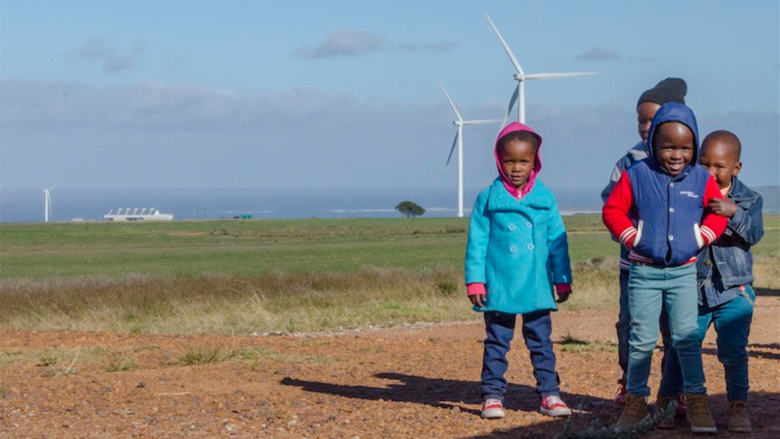In March 2015, the Kouga Wind Farm in Eastern Cape South Africa, was successfully connected to the National Electricity Grid, to supply an average of 50,000 households with clean electricity and mitigate over 270,000 tons of greenhouse gas emissions annually. This farm is one of the many green initiatives of South Africa’s Department of Energy and supplies power to Eskom, a state-owned energy company, that accounts for 95% of the nation’s energy generation, transmission and distribution. South Africa has committed to attaining substantial reductions in carbon dioxide emissions, and the National Development Plan proposes that gas and other renewable resources like wind, solar and hydroelectricity will be at least 30% of overall mix by 2025.1
Projects such as the Kouga Wind Farm are essential for an environmentally sustainable economic growth, and the need for financing for such projects is paramount. When public entities need financing to undertake infrastructure projects, a potent tool they rely on is, borrowing. But borrowing options can be limited or expensive for state-owned enterprises (SOEs) unless the government provides some risk-sharing facility such as a sovereign guarantee. The investors in Kouga Wind Farm’s case secured long-term debt funding of about R1.5-billion for the project from banks with a 20-year power purchase agreement with Eskom, and a payment guarantee from the South African Department of Energy.
Contingent liabilities in South Africa
Eskom is one of the 13 SOEs that benefit from sovereign government guarantees and accounts for 75% of the guarantee portfolio, amounting to 350 billion Rand, about 1.6% of GDP.
“Sovereign credit guarantees and government on-lending can catalyze public and private sector investment and fulfill specific policy objectives. However, contingent liabilities stemming from guarantees and on-lending expose governments to risk,” says Fritz Bachmair of the World Bank Treasury. Contingent liabilities are fiscal obligations dependent upon a specific but uncertain event that may or may not materialize in the future. They can be explicit: defined by a legal contract, or implicit: no legal obligation but severe social or economic repercussions if not serviced. The materialization of these risks creates a fiscal cost for the government.
The South African National Treasury is well known for its risk management practice. To monitor the risk of contingent liabilities, the South African National Treasury had classified the existing SOEs with a credit scorecard and a traffic light system: green for SOEs in good shape, amber for a warning signal and red for alarm. The system enabled the government to assess the credit quality of the SOEs annually and communicate it to policymakers in an intuitive fashion. The system provided an excellent way of monitoring the SOEs’ evolution regarding default risk and putting them under closer scrutiny if they moved closer to the red zone. Insights from the application of the credit scorecard can also help inform government action if elevated risk levels are observed. Risk analysis can highlight key risk drivers, and help identify appropriate actions to address these risks, including strategic adaptations, governance changes, and financial support.
The World Bank Treasury - South Africa partnership for better assessment and management of contingent liabilities
As one of the first countries joining the Government Debt and Risk Management (GDRM) Program, South Africa was interested in improving the traffic light system to quantify better the probability of the loss associated with a default risk and finetuning the existing methodology to incorporate sensitivity analysis with multiple growth and shock scenarios.
The GDRM Program team reached out internally to the World Bank’s credit risk assessment and management team as well as externally to an expert at modeling risks for banks and financial sector companies.
Together, they presented cases of alternative models used in practice, and peer-reviewed the models that the Asset and Liability Management (ALM) Division of the National Treasury developed. But most importantly, they built the capacity in the National Treasury for gathering and evaluating the data like a rating agency’s sector specialists would: by really understanding the business, the business-specific risk drivers, and the specific data that must be gathered and processed.
Making strides towards a better risk assessment system
The intervention was very timely. In March 2017, Standard & Poor’s pointed out the increased contingent liabilities as a risk to South Africa’s sovereign credit rating. As of early 2017, The South African National Treasury has written and approved Energy sector specific, finetuned methodology papers on monitoring contingent liabilities stemming from government guarantees. They have developed the capacity to identify the sector-specific risk drivers and process business-specific data better. The next steps are for the ALM team to draft a risk-based guarantee fee policy to make reserves, in case of default risk materialization and on a broader scale for the GDRM program to support the government in improving managing contingent liabilities from Public-Private Partnerships. Even though the government loan guarantees are not the only sources of contingent liabilities and while the work is not yet complete, the South African debt management office’s partnership with the World Bank Treasury GDRM Program is definitely making significant strides towards assessing and managing government’s contingent liabilities, in a much stronger way.
1 According to the South Africa department of energy IRP, 2013

